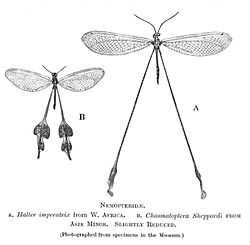Nemopteridae
| Nemopteridae |
 |
|
| Scientific classification |
| Kingdom: |
Animalia |
| Phylum: |
Arthropoda |
| Class: |
Insecta |
| Order: |
Neuroptera |
| Suborder: |
Planipennia |
| Family: |
Nemopteridae |
|
| Genera |
- Afghanocroce
- Amerocroce
- Anacroce
- Apocroce
- Austrocroce
- Barbibucca
- Brevistoma
- Carnarviana
- Chasmoptera
- Concroce
- Croce
- Derhynchia
- Dielocroce
- Halter
- Halterina
- Josandreva
- Knersvlaktia
- Laurhervasia
- Lertha
- Moranida
- Necrophylus
- Nemeura
- Nemia
- Nemopistha
- Nemoptera
- Nemopterella
- Palmipenna
- Parasicyoptera
- Pastranaia
- Pterocroce
- Savigniella
- Semirhynchia
- Sicyoptera
- Stenorrhachus
- Thysanocroce
- Tjederia
- Veurise
|
Spoonwings or Nemopteridae are a family of neuropteran insects. They are also called Thread-winged Antlions. Their flight is delicate and they have a circling flight to avoid walls when they are trapped indoors. The long streamer is conspicuous when the insects are flying and these are the elongated and spatulate hindwings.

Pinned museum specimen - Muséum of Toulouse
They are found in the Ethiopian, Palearctic, Australasian and Neotropical regions but absent in North America (a fossil has been found in Colorado).[1]
Male Nemopterids have a bulla on the wing usually along the margin or wing base that is used to disperse pheromone.[1]
Taxonomy
There are two distinct subfamilies in the Nemopteridae family:
- Crocinae, mostly nocturnal and crepuscular species with often a narrow habitat preference. They are found in arid desert zones and have a wide distribution along the southern fringes of the west Palearctic and Western Asia, as well as in dry Neotropical, Afrotropical, and Australian areas. Includes the following genera:
- Nemopterinae, diurnal, with a greater diversity. Genera include:
References
- ↑ 1.0 1.1 Grzimek's Animal Life Encyclopedia, 2nd edition. Volume 3, Insects, edited by Michael Hutchins, Arthur V. Evans, Rosser W. Garrison, and Neil Schlager. Farmington Hills, MI: Gale Group, 2003.
External links
|
|---|
| | | | Extant |
|---|
| | | D
i
c
o
n
d
y
l
i
a | |
|---|
|
- Four most speciose orders are marked in bold
- Italic are paraphyletic groups
- Based on Sasaki et al. (2013)
|
|
| | | | | |
|


 Data related to Nemopteridae at Wikispecies
Data related to Nemopteridae at Wikispecies